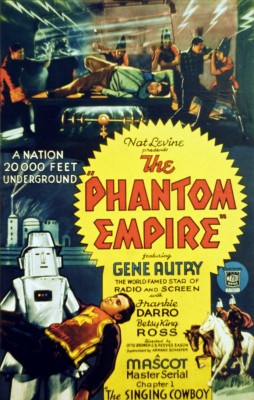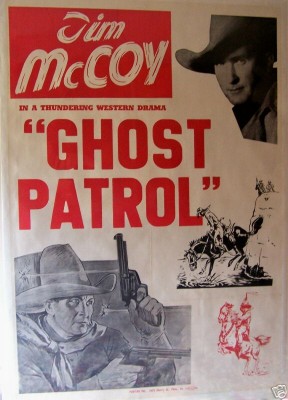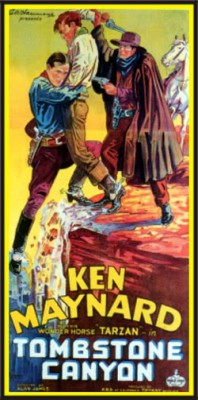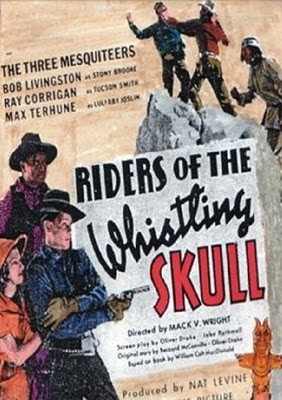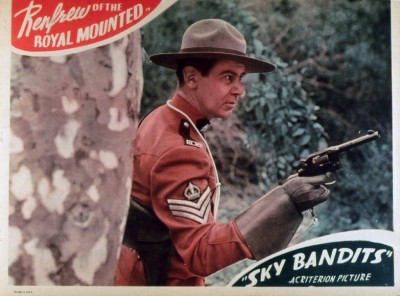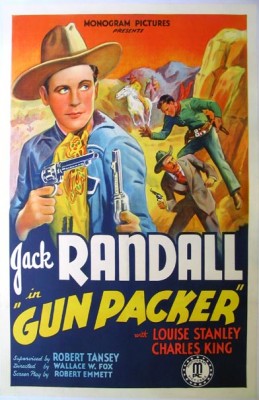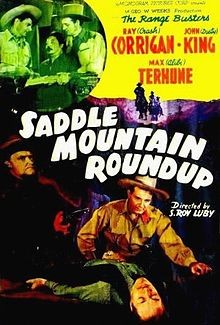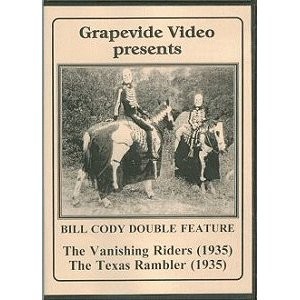| Reviews & Columns |
|
Reviews DVD TV on DVD Blu-ray 4K UHD International DVDs In Theaters Reviews by Studio Video Games Features Collector Series DVDs Easter Egg Database Interviews DVD Talk Radio Feature Articles Columns Anime Talk DVD Savant Horror DVDs The M.O.D. Squad Art House HD Talk Silent DVD
|
DVD Talk Forum |
|
|
| Resources |
|
DVD Price Search Customer Service #'s RCE Info Links |
|
Columns
|
|
|
Big Box of Cowboys, Aliens, Robots and Death Rays (8 movies), A
One word of caution: though the product is labeled region-free, in fact the disc is region 1 encoded. This is the second S'more Entertainment release I've noticed to make this mistake. No extra features, though the menu screens and chapter options are better than usual, too.
Radio Ranch features the most overt fantasy elements, namely a lost but super-scientific civilization with requisite robots (wearing steel hats) and ray-guns. However, it's also the one movie in this set I encourage the reader not to watch.
That's because Radio Ranch, is a bastardized, featurized, and now public domain version of the 12-chapter Mascot serial The Phantom Empire (1935). This very strange chapter-play was Gene Autry's first starring role. He more or less plays himself, a singing cowboy and radio star, whose dude ranch is also from whence Gene hosts his 2:00 pm radio broadcast.
Gene, along with young pals Betsy King Ross (Betsy King Ross) and Frankie Darro (Frankie Darro), is kidnapped by horse soldiers from the underground civilization of Murania, decedents of the long-lost Mu Empire. Oddly, as monumental a discovery as this would seem to be, much of the plot involves Gene trying to get back to the dude ranch in order to make his two o'clock broadcast.
The original serial was more than four hours long in total, so like other bowdlerized serials this 68-minute condensation is pretty incoherent. What's more, the entire, fully restored serial is available on DVD via Gene Autry's estate, a June 2011 release from Timeless Media. Instead of watching this dog-eared copy, why not treat yourself to the complete, fully restored version instead? (** out of *****)
Video & Audio: On the weaker side and while not terrible, it can't compete at all with the Autry Estate release.
Ghost Patrol stars Tim McCoy as G-man Tim Caverly, who's investigating the mysterious downing of airmail planes then looted of their cash shipments, bonds and other negotiable items. Tim, posing as tough hombre Tim Toomey, infiltrates a group of bad guys hold up in the ghost town of Shiloh, thieves led by Ted Dawson (Walter Miller) and his key henchmen, Kincaid (Wheeler Oakman) and Charlie (Dick Curtis).
There, Tim also encounters Natalie Brent (Claudia Dell), a young woman searching for her scientist father, he last seen conducting experiments in a radium mine located beneath the same abandoned house where the bad guys are headquartered. It turns out the naïve Professor Brent (Lloyd Ingraham) is using a fantastic ray - played by Kenneth Strickfaden's familiar electrical gizmos - to bring down the aircraft.
Tim McCoy is definitely of the older school of movie cowboys. Prior to his discovery during the silent era, McCoy was a skilled, authentic cowboy and apparently fluent in Native American sign language. Conversely, his screen image is almost outrageously unreal. He wears an enormous 10-gallon (20-gallon?) hat and other costuming that makes him look a bit like "Dripalong Daffy."* McCoy also has the strange habit of firing his six-guns as if they were whips, making flamboyant wrist-snapping motions with each shot.
The movie is routine and the airplane scenes border on incompetent. Tim flies into the Shiloh area deliberately hoping his airmail plane will be brought down. When the ray is turned against him, the sound effects are indescribably bad. When the engine stalls it sounds like someone crudely plugging and unplugging recorded audio of a plane engine. Not only is this not effective, it had me wondering if my own television's speakers had gone on the blink, or if something was wrong with the transfer. When the plane spirals out of control the effect is like a slide whistle. (**)
Video & Audio: Not bad at all. Obviously from 16mm, given the reel change cues and the rougher state at the head and tail of each reel but eminently watchable.
Ken Maynard, the B-Western cowboy as reviled off-screen as he was beloved on it, top-lines Tombstone Canyon, a routine oater notable for its mysterious "Phantom" and good use of Red Rock Canyon. The familiar tale has Ken Mason (Maynard) en route to visit Luke, who plans on revealing the identity of Ken's long-lost father.
In Tombstone Canyon three men fire upon Ken and later he finds Luke dead, murdered in his cabin. The local populace blames "The Phantom" (Sheldon Lewis), a black-caped type lurking about the canyons like Bela Lugosi. However, Jenny Lee (Cecilia Parker, later Mickey Rooney's big sister in the "Andy Hardy" films) explains the Phantom only kills the henchmen of local baddie Alf Sikes (Frank Brownlee).
While investigating Luke's murder, Ken goes to work for Colonel Lee (Lafe McKee), Jenny's rancher father. Sikes, meanwhile, tries to pin his various crimes on both Ken and the Phantom, whom some townsfolk believe are one and the same.
The best thing about Tombstone Canyon is its outrageous movie company logo, for World Wide Pictures, Inc. It features a pretty blonde smiling cheerfully while holding two colossal globes against her chest, suggesting a different movie altogether, maybe Tombstone Canyon of the Ultra-Vixens. Instead, there's a lot of talk between Ken and his horse, Tarzan. Like Roy Rogers did later with Trigger, Tarzan was prominently featured in Maynard's films until the steed's death in 1940. Tarzan rescues Ken twice in this. The first time Ken is so embarrassed to impose upon his friend he actually apologies to the horse.
The Phantom himself isn't much, just an ugly man whose face has been "stamped in" according to the dialogue, though it's a normal face with no horror makeup. Actor Sheldon Lewis apparently played a similar role in The Phantom (1931), as "The Thing," and also appears in The Monster Walks (1932). (** 1/2)
Video & Audio: Pretty good. Whites run a little hot and it has its share of scratches, reel change punch holes and the like, but quite clear and reasonably sharp.
The awkwardly titled The Riders of the Whistling Skull was the fourth of 51 "Three Mesquiteers" B-Westerns produced by Republic Pictures from 1936-1943. The series was somewhat unusual in that, while very popular, it frequently shuffled its three leads, none of which were with the series start-to-finish. This one stars the most familiar combo: Bob Livingston as Stony Burke, Ray "Crash" Corrigan as Tucson Smith, and Max Terhune as Lullaby Joslin, the latter accompanied by his ventriloquist dummy, Elmer. That trio-and-a-half made up most of the first 22 films or so, though John Wayne replaced Livingston as Stony Burke for eight films. (This was before, during, and after Stagecoach's release, a bitter pill in Duke's hard-fought career climb.)
The series appealed mainly to kids, though like a lot of other B-Westerns these 1930s entries tend to be a bit more adult and less mechanical and formulaic than the entries that followed.
The goofy plot has the boys escorting a group of archeologists searching for the lost Indian city of Luckachakai, as well as aiding Betty Marsh (Mary Russell), who's trying to locate her missing archeologist father.
The picture is fairly ordinary until the larger-than-usual group of explorers reach Luckachakai, played in part by a glass painting of a skull-like rock formation obviously patterned after King Kong's Skull Island. There they battle the Sons of Anatazia, an Indian cult, as well as unscrupulous white folk. They take refuge in the skull-cave - "Head for the skull!" someone shouts - and the rest of the picture is an orgy of special effects and stunt work, the kind of thing Republic Studios did especially well during this period.
The movie is slightly elaborate by Republic standards though awfully clunky in other ways, especially the acting. Most though not all the actors ... carefully ... enunciate ... every ... word. It's like watching one of those stilted early talkies, when actors were encouraged to supposes Moses toeses were roses. (** 1/2)
Video & Audio: This one sources an early television print from the '50s, one that seems to have cut the picture by five or six minutes, though the complete film might no longer survive. (Republic's film library is probably the most irreparably harmed in all of Hollywood.) There's a fair amount of damage though the image is okay, considering.
In Sky Bandits, Canadian Mountie Sgt. Renfrew (James Newill) and Constable Kelly (Dave O'Brien) are investigating the mysterious downing of airmail planes which are then looted of their gold. Renfrew also encounters Madeline Lewis (Louise Stanley), a young woman searching for her scientist father, last seen conducting experiments on a powerful radio beam.
Hmmm. Sound familiar?
A loose remake of Ghost Patrol, this was the last of five "Renfrew of the Royal Mounted" movies produced by Criterion Pictures and distributed initially by Grand National and later by Monogram during 1937-1940. These in turn were based on the popular series of boy's adventure books written by Laurie York Erskine from 1922-1941. (The credits claim this was based on Erskine's Renfrew Rides the Sky, however.)
Not bad and slightly livelier than its predecessor if still cheap, plus the supporting cast includes Dwight Frye (Dracula, Frankenstein), silent comedian "Snub" Pollard, and genre character player Kenne Duncan, among others. And the sound effects are better. (** 1/2)
Video & Audio: Obviously sourced from 16mm - the edges of the frame are clearly visible - but not terrible.
A harmless but extremely minor B-Western starring Addison "Jack" Randall, real-life brother of Mesquiteer Bob Livingston, Gun Packer barely qualifies for this set. The marginally science-fiction aspect of the story is how Sierra Stagecoach Company robbers manage to smuggle their stolen gold: a wily professor pours the gold back "over the ore, just like nature does."
The rest of this 50-minute film is instantly forgettable. I saw it only yesterday yet barely remember it. Randall has decent chemistry with his character's love interest, Ruth Adams (Louise Stanley), and well he should. The couple apparently fell in love while making this and married soon thereafter. It must have been a whirlwind romance, considering that this couldn't have taken more than four or five days to shoot. Loveable ol' lug Glenn Strange has a nice, somewhat atypical role as the local sheriff.
In a move rare for such films, African-American actor Ray Turner plays Randall's sidekick, Pinkie. Turner was a busy bit player normally limited to the often-demeaning roles African-Americans were stuck with during the '30s and '40s. But his role here is refreshingly dignified, subdued even by B-Western sidekick standards. It's no part like Morgan Freeman's in Unforgiven, but it does offer a couple of minor surprises. (**)
Video & Audio: A Monogram production, this title doesn't look half bad. All things considered, above average for a public domain title of this vintage and obscurity.
After Mesquiteers Ray "Crash" Corrigan and Max Terhune left Republic Pictures following a salary dispute, Corrigan set up a sweet deal at Monogram to do essentially the same series there. Joined by John "Dusty" King in the juvenile lead/singing cowboy role, the "Range Busters" films were almost literally indistinguishable from Republic's Three Mesquiteers series, though Monogram's budgets are noticeably tighter, if marginally so.
Corrigan seems to have been a real workaholic, constantly scheming and willing to do just about anything for a buck. He'd been a stuntman before becoming an actor, often wearing an elaborate gorilla costume he owned for jungle movies and the like. He also converted some acreage he'd bought in Simi Valley, northwest of Los Angeles, into the Corriganville Movie Ranch (then called the Ray Corrigan Ranch), a multi-use location with Western streets and equipment that was cheap and convenient for both big and little movie companies. Part of Corrigan's deal with Monogram was that the Range Busters series would be shot there, and he later claimed to have reaped half of that series' profits.
Saddle Mountain Roundup was the ninth of 24 Range Busters movies, 16 of which starred Corrigan, King, and Terhune. Though included here for its supposed but almost nonexistent horror elements, it's nonetheless a genre hybrid, mixing B-Western action with very typical murder mystery elements.
Crotchety ranger "Magpie" Harper is a real suspicious type, believing everyone is out to steal his hidden fortune and, sure enough, one stormy night he's gunned down. The Range Busters, hired to guard Magpie's herd during a cattle drive, arrive to investigate, interviewing, among others, suspects like Magpie's foreman, Blackie (George Chesebro), and Chinese cook Fang Way (Willie Fung).
Surprisingly good for such a low-rent, impoverished studio like Monogram, this and other Range Busters movies compensate for their cheapness with a real spirit of fun that's pretty infectious. The opening titles, for instance, place the actors and some members of the crew in picturesque diorama-type settings while their theme song, "Home on the Range," is heard on the soundtrack. There's a pleasant camaraderie among the three leads, and the acting is light years ahead of The Riders of the Whistling Skull.
And, unlike that earlier film, where Terhune's dummy, Elmer, makes but a token appearance, the sidekick's sidekick is prominently featured here. To modern eyes Elmer's role in the film borders on the bizarre. A major plot point has Crash Corrigan stumbling upon Elmer's hairpiece. When Terhune is captured and interrogated by the bad guys, Elmer speaks up prompting one heavy to remark, "Oh, so you're in on this, too!"
Willie Fung is amusing if racially stereotyped as the Chinese cook - "Bossy likey kethchie, maybe? Me vely sawly!" (You are forgiven if you confuse Fung with Victor Wong, a contemporary best known as Charlie the cook in King Kong.) (***)
Video & Audio: A step down from everything on discs 1-3, but still not terrible. Even on a relatively big (45-inch) monitor, it was perfectly watchable, despite frequent splices, scratches, and a general dupeiness.
No relation to "Buffalo" Bill Cody, the "reel" Bill Cody nevertheless parlayed that opportune coincidence into a long career in B-Westerns, movies often featuring his talented son, Billy Jr. The Vanishing Riders has the two Bills trying to stop cattle rustler Wolf Lawson* (Hal Taliaferro) and his gang by masquerading as ghostly riders, disguising themselves and their horses as living skeletons, similar to Dr. Syn: A Tale of Romney Marsh.
The movie is quite cheap and Bill Cody comes off as a second-rate Hopalong Cassidy, even wearing a similar all-black outfit. His old pal Hiram McDuff (Budd Buster), is a white-haired Gabby Hayes imitator, though in fairness Hayes was just beginning to establish his famous persona. But ten-year-old Billy Jr. is a real find. In the opening scene Billy finds his father dead after a shoot-out. Sheriff Bill Jones (Cody Sr.) is so moved by the boy's grief that he adopts him on the spot. What might have been maudlin Billy Jr. handles with surprising finesse and verisimilitude. Later, Billy Jr. clamors over some rooftops apparently without the aide of a stuntman, and later still on horseback he successfully lassos Wolf riding at a full gallop.
Somewhat unusual for a film of this type, the singing is done by Wolf's henchmen, prompting a strong reprimand from their boss: "You want to tip off everybody in the county where we are?! Why, I could hear you singing a mile down the trail!" (**)
Video & Audio: Once again, it's obviously from 16mm, but not bad especially considering this comes from Spectrum Pictures, an ultra-cheap outfit distributing product on a states-rights basis.
Video & Audio
See above for individual QC analysis. As noted above, though it claims to be region-free the discs are actually Region 1 encoded, so beware. Another complaint is the flimsiness of the disc hubs. Every time I picked up the case Discs 1 and 4 invariably fell out. But the menu screens and chapter stop options are good, and the English-only mono audio is always coherent. No alternate audio or subtitle options, and no Extra Features.
Parting Thoughts
You get lots of Cowboys and a few Death Rays, but only a smattering of Robots and no Aliens at all in this Big Box. However, for fans of B-Westerns the transfers are above average for public domain titles and for them this set is heartily Recommended.
* Sergei Hasenecz writes, "The hat may be big, but it's authentic. Many of the smaller cowboy hats you see in later Westerns of the '40s and especially into the '50s are the phonies. Check out what Tom Mix, Buck Jones, Hoot Gibson and Col. Tim (all of them working cowboys before they were movie stars) wore in the teens through [the] '30s. Those are the real hats. The kerchief is flamboyant, as is his style of gunplay. McCoy was closer to Mix than Hart when it came to showmanship and escapism, but his Western bona fides were in order. He ranched in Wyoming and learned sign language from the Arapahoe on the Wind River reservation, where he was known as High Eagle."
** The name probably derived from Capt. Wolf Larsen, from Jack London's The Sea-Wolf.
Stuart Galbraith IV's audio commentary for AnimEigo's Tora-san, a DVD boxed set, is on sale now.
|
| Popular Reviews |
| Sponsored Links |
|
|
| Sponsored Links |
|
|
| Release List | Reviews | Shop | Newsletter | Forum | DVD Giveaways | Blu-Ray | Advertise |
|
Copyright 2024 DVDTalk.com All Rights Reserved. Legal Info, Privacy Policy, Terms of Use,
Manage Preferences,
Your Privacy Choices | |||||||









